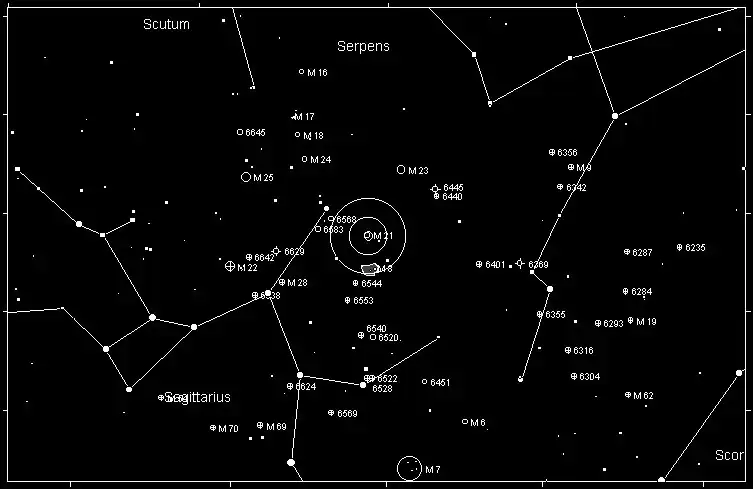Messier 21 (M21), also known as NGC 6531, is an open star cluster located in the constellation Sagittarius. Discovered by Charles Messier in 1764, M21 is a relatively young cluster, estimated to be around 4.6 million years old. This cluster contains about 57 confirmed stars, with many being massive, hot, and luminous. Though not as famous as its neighbor, the Trifid Nebula (M20), M21 offers amateur astronomers a splendid view of stars scattered in a compact region.
Magnitude
Messier 21 has an apparent magnitude of 6.5, making it faintly visible to the naked eye under exceptionally dark skies. However, it is easily spotted with binoculars or a small telescope. Despite its relatively dim magnitude, M21's stars shine brightly enough to stand out against the Milky Way's dense background, where it is located.
Prominent Season
M21 is best observed during the summer months in the Northern Hemisphere. Sagittarius, the constellation in which it resides, is at its highest in the sky during this time, particularly in July and August. Observers in southern latitudes can enjoy this cluster as well, though it will appear higher in their sky.
Constellation
M21 lies in the constellation Sagittarius, often referred to as the "Archer." Sagittarius is famous for its bright asterism known as the "Teapot," which helps stargazers locate numerous deep-sky objects, including Messier 21. Sagittarius is home to the center of our galaxy, the Milky Way, making it a rich hunting ground for clusters, nebulae, and other astronomical wonders.
How to Find Messier 21
To locate M21, start by identifying the Sagittarius constellation in the sky. Look for the prominent "Teapot" asterism, which is easily recognizable by its shape. The spout of the teapot points toward the direction of the center of the Milky Way. Just above the "spout" of the teapot lies the Trifid Nebula (M20), a famous object due to its bright and dark nebulosity. M21 is located about 0.75 degrees northeast of the Trifid Nebula, meaning they both easily fit within the same field of view using a low-power telescope.
A small telescope will reveal a compact cluster of stars, and if you increase the magnification, you will be able to resolve more individual stars within the cluster. M21 is a beautiful sight, particularly when viewed alongside M20.

History
Messier 21 was discovered by the French astronomer Charles Messier on June 5, 1764, during his hunt for comet-like objects. Messier was compiling a list of nebulous objects that could be mistaken for comets, and this eventually became the famous Messier Catalogue. Though M21 wasn't his most famous discovery, it earned a place in his catalogue and has been observed by astronomers for centuries.
Given its relatively young age of just a few million years, M21 is a fascinating object for studies of stellar formation and evolution. The stars within the cluster are still in the early stages of their life cycle, and astronomers have observed several massive B-type stars, which are known for their blue color and intense luminosity. These young, hot stars will eventually evolve into red giants and supernovae, enriching the surrounding interstellar medium with heavy elements.
Conclusion
Messier 21 is a delightful open star cluster nestled within the rich star fields of the Sagittarius constellation. While it may not boast the grandeur of some of the more well-known clusters, it offers a rewarding target for amateur astronomers, particularly when viewed in conjunction with nearby objects like the Trifid Nebula. Best viewed during the summer months, M21 provides a glimpse into the early stages of stellar evolution and the beauty of the Milky Way's star-forming regions.
